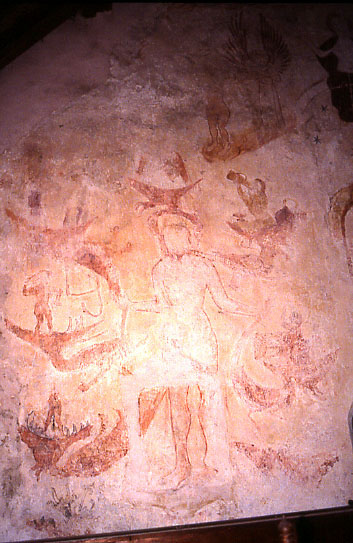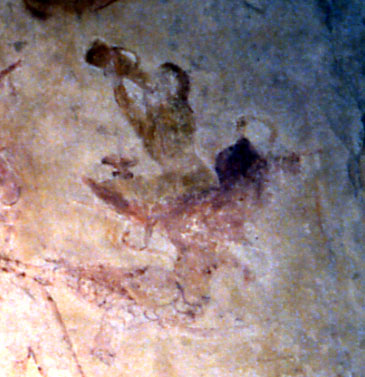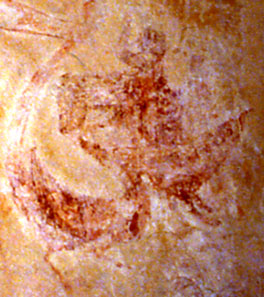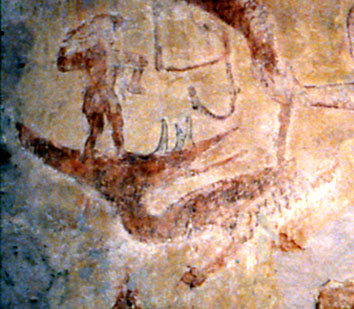Trotton, W Sussex (†Chichester) C.14
The Seven Deadly Sins, with Judgement details & Moses

The most immediately noticeable thing about this subject, which shares the west wall of the church with the Seven Works of Mercy, is that the individual Sins, unlike the individual Works, are not painted in roundels. Instead, they proceed directly from various parts of a central figure’s body in much the same way as many of the other examples of the subject in the table below. Tristram remarked in discreet parentheses that the central figure was ‘when first discovered, phallic’.¹ He does not elaborate, but in all likelihood the phallus was painted out or carefully draped subsequently. Otherwise, the general layout of the details is similar to the Seven Works of Mercy, with another figure on a cloud-promontory at the upper right, representing this time the Damned Soul who will not be received into Heaven. This figure faces outwards, into the centre of the painting, driven away by an angel.
The personified sins are, again as so often – Raunds and Hoxne are the clearest examples – shown proceeding from the toothed jaws of dragons. Pride, above the central figure’s head, has effectively gone, but Gluttony (detail, below left), issuing appropriately from the mouth, is much clearer.

Personified Gluttony drinks deep from a large jug, with a flagon beside him and possibly a third behind – Tristram, who examined the painting when it was in better condition, saw a flagon and a large dish, but these details are far from clear now. The individual scales on the dragon out of whose mouth the drinking figure comes show quite well though.
The painting generally is much less well preserved than the Seven Works of Mercy, and only two of the remaining scenes are clear enough to show in detail. The less clear of the two, painted directly below Gluttony and issuing from the central figure’s right hand, is Avarice (below right).

The Avarice-figure clutches a large coffer with a rounded lid, open according to Tristram although the detail is not clear now. Tristram also saw him repelling a small devil holding a three-pronged fork, but this too has faded into invisibility. Wrath, in the corresponding position on the other side of the main figure and shown here at the left, is rather clearer, and features a standing man apparently holding something to his head, most probably intended for a knife or a whip with which he wounds himself. His left arm is held in an awkwardly contorted posture, probably to convey the idea that he has some other self-lacerating weapon in this hand as well.

So far as the remaining sins are concerned Lust is likely to have been beside the central figure’s right leg and probably once showed two people embracing. The sin shown by the left foot was probably Sloth – it is virtually indecipherable now but according to Tristram it once showed a man in a cloak lying on a couch. This leaves Envy, which must be the sin shown on the spectator’s left at head level, opposite Gluttony.
Below the sins at the bottom left is part of a large devil with long horns, just decipherable in the main picture. He once had a three-pronged fork and stood within the gaping jaws of a Hell-mouth, according to Tristram.
The ambitious scheme on the west wall at Trotton must have been very striking when it was first painted. The contrasts and consequences it embodies would have made its meaning unambiguously plain to literate and illiterate alike, and its position would make it very difficult to go out of the church without confronting its moral lesson.
(Click here for the Seven Works of Mercy at Trotton)
Website for St George’s, Trotton
¹ Tristram III, p. 259
† in page heading = Diocese